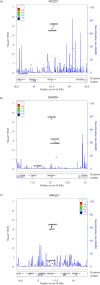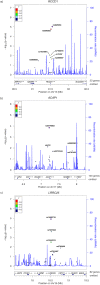Cis-eQTL-based trans-ethnic meta-analysis reveals novel genes associated with breast cancer risk
- PMID: 28362817
- PMCID: PMC5391966
- DOI: 10.1371/journal.pgen.1006690
Cis-eQTL-based trans-ethnic meta-analysis reveals novel genes associated with breast cancer risk
Abstract
Breast cancer is the most common solid organ malignancy and the most frequent cause of cancer death among women worldwide. Previous research has yielded insights into its genetic etiology, but there remains a gap in the understanding of genetic factors that contribute to risk, and particularly in the biological mechanisms by which genetic variation modulates risk. The National Cancer Institute's "Up for a Challenge" (U4C) competition provided an opportunity to further elucidate the genetic basis of the disease. Our group leveraged the seven datasets made available by the U4C organizers and data from the publicly available UK Biobank cohort to examine associations between imputed gene expression and breast cancer risk. In particular, we used reference datasets describing the breast tissue and whole blood transcriptomes to impute expression levels in breast cancer cases and controls. In trans-ethnic meta-analyses of U4C and UK Biobank data, we found significant associations between breast cancer risk and the expression of RCCD1 (joint p-value: 3.6x10-06) and DHODH (p-value: 7.1x10-06) in breast tissue, as well as a suggestive association for ANKLE1 (p-value: 9.3x10-05). Expression of RCCD1 in whole blood was also suggestively associated with disease risk (p-value: 1.2x10-05), as were expression of ACAP1 (p-value: 1.9x10-05) and LRRC25 (p-value: 5.2x10-05). While genome-wide association studies (GWAS) have implicated RCCD1 and ANKLE1 in breast cancer risk, they have not identified the remaining three genes. Among the genetic variants that contributed to the predicted expression of the five genes, we found 23 nominally (p-value < 0.05) associated with breast cancer risk, among which 15 are not in high linkage disequilibrium with risk variants previously identified by GWAS. In summary, we used a transcriptome-based approach to investigate the genetic underpinnings of breast carcinogenesis. This approach provided an avenue for deciphering the functional relevance of genes and genetic variants involved in breast cancer.
Conflict of interest statement
The authors have declared that no competing interests exist.
Figures


References
-
- Ferlay J, Soerjomataram I, Ervik M, Dikshit R, Eser S, Mathers C, et al. GLOBOCAN 2012 v1.0, Cancer Incidence and Mortality Worldwide: IARC CancerBase No. 11 [Internet]. Lyon, France: International Agency for Research on Cancer; 2013. Available from: http://globocan.iarc.fr, accessed on 09/19/2016.
-
- Pharoah PD, Day NE, Duffy S, Easton DF, Ponder BA. Family history and the risk of breast cancer: a systematic review and meta-analysis. Int J Cancer. 1997; 71(5):800–9. - PubMed
Publication types
MeSH terms
Substances
Grants and funding
- U01 CA069417/CA/NCI NIH HHS/United States
- R01 CA142996/CA/NCI NIH HHS/United States
- UM1 CA164920/CA/NCI NIH HHS/United States
- T32 GM067547/GM/NIGMS NIH HHS/United States
- MC_QA137853/MRC_/Medical Research Council/United Kingdom
- R01 CA184585/CA/NCI NIH HHS/United States
- R01 CA064277/CA/NCI NIH HHS/United States
- U01 CA098758/CA/NCI NIH HHS/United States
- K25 HL121295/HL/NHLBI NIH HHS/United States
- U01 CA098710/CA/NCI NIH HHS/United States
- R01 CA100598/CA/NCI NIH HHS/United States
- P30 ES010126/ES/NIEHS NIH HHS/United States
- UM1 CA164973/CA/NCI NIH HHS/United States
- T32 CA112355/CA/NCI NIH HHS/United States
- U01 CA127298/CA/NCI NIH HHS/United States
- R37 CA070867/CA/NCI NIH HHS/United States
- R01 CA201358/CA/NCI NIH HHS/United States
- R01 CA073629/CA/NCI NIH HHS/United States
- R25 CA112355/CA/NCI NIH HHS/United States
- P50 CA058223/CA/NCI NIH HHS/United States
- R01 CA100374/CA/NCI NIH HHS/United States
- U01 CA098216/CA/NCI NIH HHS/United States
- U01 HG005922/HG/NHGRI NIH HHS/United States
- K05 CA136967/CA/NCI NIH HHS/United States
- R01 CA063464/CA/NCI NIH HHS/United States
- R01 CA063446/CA/NCI NIH HHS/United States
- U01 CA098233/CA/NCI NIH HHS/United States
- R01 CA054281/CA/NCI NIH HHS/United States
- U01 CA063464/CA/NCI NIH HHS/United States
- R01 CA132839/CA/NCI NIH HHS/United States
- R01 CA088164/CA/NCI NIH HHS/United States
- U19 CA148065/CA/NCI NIH HHS/United States
- MC_PC_12028/MRC_/Medical Research Council/United Kingdom
- R37 CA054281/CA/NCI NIH HHS/United States
- R01 CA120120/CA/NCI NIH HHS/United States
- K24 CA169004/CA/NCI NIH HHS/United States
LinkOut - more resources
Full Text Sources
Other Literature Sources
Medical
Molecular Biology Databases
Miscellaneous

